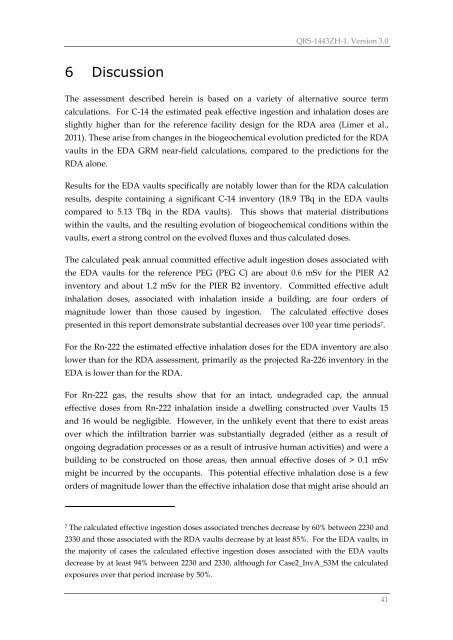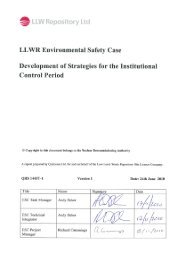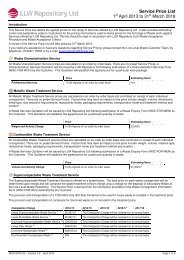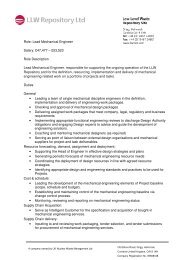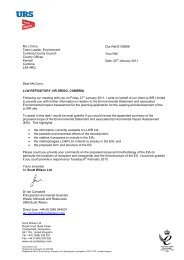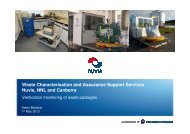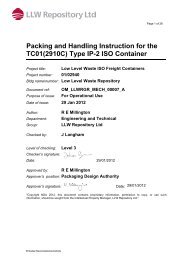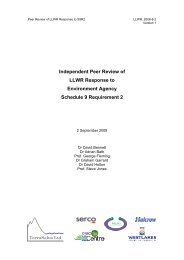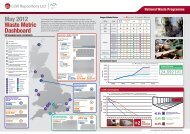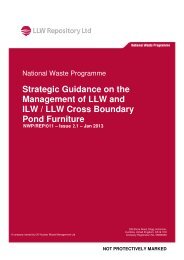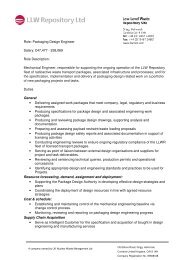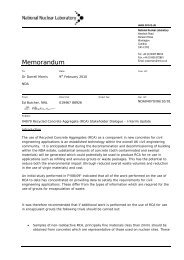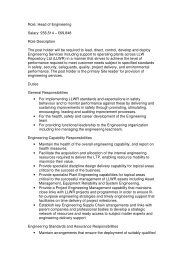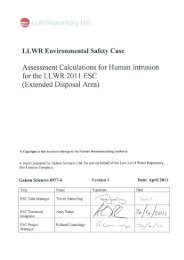Limer LMC, Assessment Calculations for C-14 Labelled Gas and ...
Limer LMC, Assessment Calculations for C-14 Labelled Gas and ...
Limer LMC, Assessment Calculations for C-14 Labelled Gas and ...
You also want an ePaper? Increase the reach of your titles
YUMPU automatically turns print PDFs into web optimized ePapers that Google loves.
QRS-<strong>14</strong>43ZH-1, Version 3.06 DiscussionThe assessment described herein is based on a variety of alternative source termcalculations. For C-<strong>14</strong> the estimated peak effective ingestion <strong>and</strong> inhalation doses areslightly higher than <strong>for</strong> the reference facility design <strong>for</strong> the RDA area (<strong>Limer</strong> et al.,2011). These arise from changes in the biogeochemical evolution predicted <strong>for</strong> the RDAvaults in the EDA GRM near-field calculations, compared to the predictions <strong>for</strong> theRDA alone.Results <strong>for</strong> the EDA vaults specifically are notably lower than <strong>for</strong> the RDA calculationresults, despite containing a significant C-<strong>14</strong> inventory (18.9 TBq in the EDA vaultscompared to 5.13 TBq in the RDA vaults). This shows that material distributionswithin the vaults, <strong>and</strong> the resulting evolution of biogeochemical conditions within thevaults, exert a strong control on the evolved fluxes <strong>and</strong> thus calculated doses.The calculated peak annual committed effective adult ingestion doses associated withthe EDA vaults <strong>for</strong> the reference PEG (PEG C) are about 0.6 mSv <strong>for</strong> the PIER A2inventory <strong>and</strong> about 1.2 mSv <strong>for</strong> the PIER B2 inventory. Committed effective adultinhalation doses, associated with inhalation inside a building, are four orders ofmagnitude lower than those caused by ingestion. The calculated effective dosespresented in this report demonstrate substantial decreases over 100 year time periods 7 .For the Rn-222 the estimated effective inhalation doses <strong>for</strong> the EDA inventory are alsolower than <strong>for</strong> the RDA assessment, primarily as the projected Ra-226 inventory in theEDA is lower than <strong>for</strong> the RDA.For Rn-222 gas, the results show that <strong>for</strong> an intact, undegraded cap, the annualeffective doses from Rn-222 inhalation inside a dwelling constructed over Vaults 15<strong>and</strong> 16 would be negligible. However, in the unlikely event that there to exist areasover which the infiltration barrier was substantially degraded (either as a result ofongoing degradation processes or as a result of intrusive human activities) <strong>and</strong> were abuilding to be constructed on those areas, then annual effective doses of > 0.1 mSvmight be incurred by the occupants. This potential effective inhalation dose is a feworders of magnitude lower than the effective inhalation dose that might arise should an7 The calculated effective ingestion doses associated trenches decrease by 60% between 2230 <strong>and</strong>2330 <strong>and</strong> those associated with the RDA vaults decrease by at least 85%. For the EDA vaults, inthe majority of cases the calculated effective ingestion doses associated with the EDA vaultsdecrease by at least 94% between 2230 <strong>and</strong> 2330, although <strong>for</strong> Case2_InvA_S3M the calculatedexposures over that period increase by 50%.41


